Gain insights into how sheaves in the Bible symbolize divine provision and hope, unveiling a deeper spiritual connection awaiting exploration.
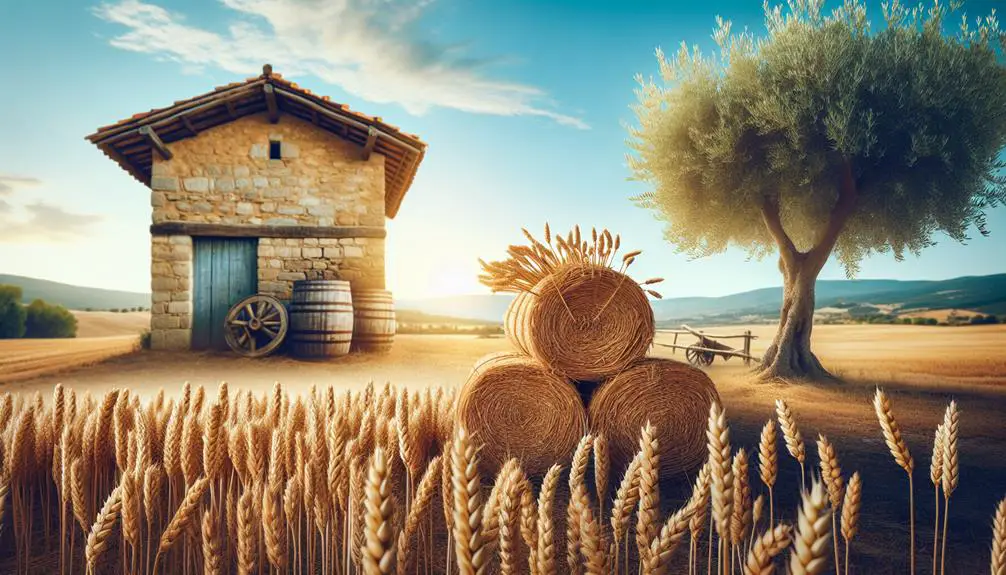
Define Sheaves in the Bible
As they say, a journey of a thousand miles begins with a single step, so let's take that step towards understanding the concept of sheaves in the Bible.
You might find that sheaves are not just bundles of grain; they carry a weightier significance throughout biblical history. From Joseph's dream to the celebratory Psalms, sheaves weave a narrative of divine provision, hope, and collective joy.
But how exactly do these ancient agricultural practices reflect broader spiritual truths? Stick around, and you'll discover how sheaves symbolize more than just the harvest—they represent a deeper connection between humanity and the divine.
Key Takeaways
- Sheaves symbolize abundance, divine provision, and God's faithfulness in biblical narratives.
- Joseph's dream involving sheaves foretold his future leadership and highlighted dream interpretation as a divine gift.
- In Psalms, sheaves represent spiritual bounty, renewal, and gratitude for God's enduring faithfulness.
- Sheaves emphasize unity, stewardship, and the importance of community bonds through sharing God's blessings.
Historical Context of Sheaves
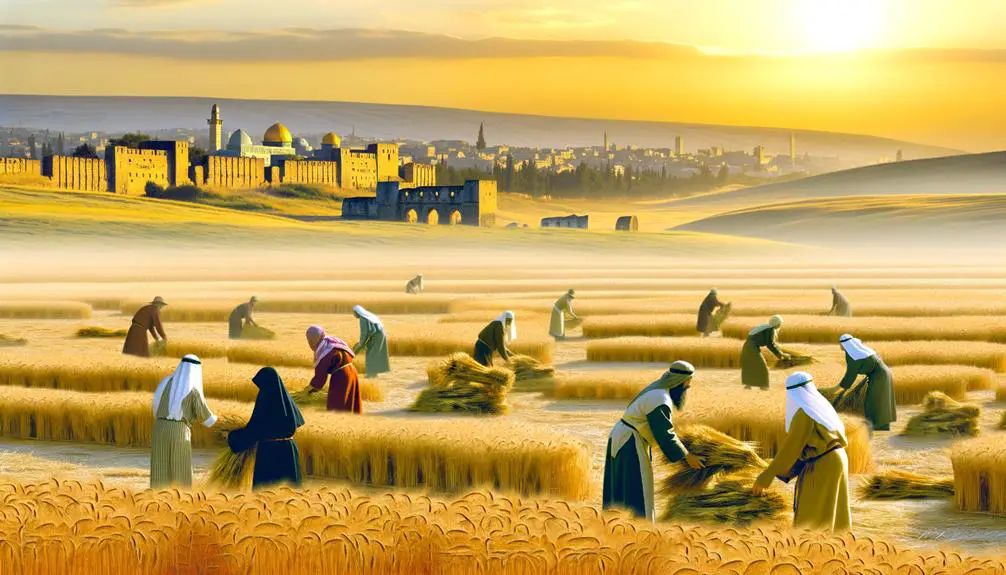
In exploring the historical context of sheaves within the Bible, it's crucial to understand how these bundles of grain not only sustained societies but also symbolized abundance and divine provision in ancient agricultural communities. You're diving into a realm where agricultural practices weren't merely a means of survival but deeply intertwined with the cultural and spiritual fabric of the people.
These practices, manifesting through the cutting, bundling, and gathering of sheaves, were imbued with profound cultural significance, reflecting the community's reliance on divine benevolence for their sustenance and prosperity.
Sheaves, as you'll find, were more than agricultural produce; they were a tangible representation of God's mercy and faithfulness. In societies where the rhythm of life was dictated by the seasons of planting and harvest, sheaves became a focal point of communal and religious life. The process of reaping the grain, binding it into sheaves, and then bringing these bundles to the threshing floor was laden with symbolism. It wasn't just about the physical nourishment these sheaves provided but also the spiritual sustenance they represented.
This deep connection between the agricultural practices surrounding sheaves and their cultural significance is evident throughout the biblical narrative. It highlights how fundamental these practices were in shaping the identity and religious expressions of ancient communities. Through this lens, you're able to appreciate the multifaceted role sheaves played in not only feeding the body but also nourishing the soul, serving as a reminder of the enduring relationship between the divine and the mundane.
Sheaves in Joseph's Dream

Reflecting on the historical and cultural significance of sheaves highlights their symbolic role in one of the most pivotal biblical narratives: Joseph's dream. In this account, Joseph shares with his brothers a dream in which their sheaves of grain bow down to his standing sheaf. This image not only foretells Joseph's future ascendancy over his family but also delves deeply into the realms of dream interpretation and familial dynamics within a faith-based context.
The act of interpreting dreams, especially in the biblical era, was considered a divine gift, a means through which God communicated His will and intentions to mankind. Joseph's ability to interpret dreams, including his own, set him apart and marked a significant turning point in his life's journey. His dream about the sheaves, therefore, isn't just a narrative about agricultural practices or sibling rivalry; it's a profound exploration of destiny, divine intervention, and the intricate web of family relationships.
The familial dynamics at play are particularly telling. Joseph's brothers' reaction to his dream—envy and disbelief—underscores the tension and discord that often accompany familial relations, especially in contexts where future leadership and favoritism are at stake. This narrative invites you to ponder the complexities of sibling relationships, the weight of dreams and their interpretations, and the notion that sometimes, divine plans are revealed in the most unexpected ways.
Symbolism in the Harvest
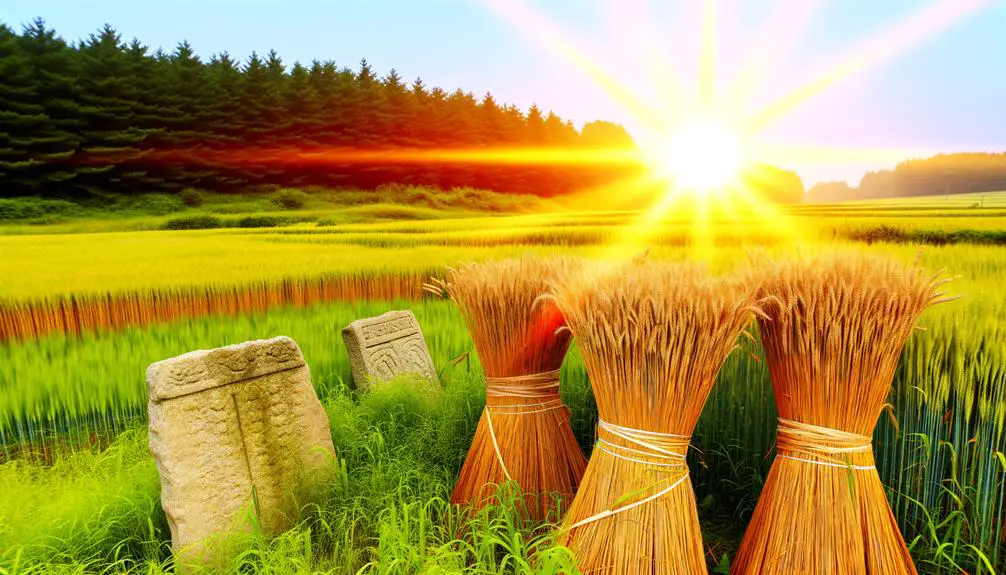
Delving into the symbolism of the harvest reveals its multifaceted role as a metaphor for spiritual growth, divine providence, and the cyclical nature of life within the biblical narrative. The imagery of harvest not only conveys the idea of physical sustenance but also encapsulates profound spiritual truths that resonate with the faithful. You'll find that agricultural rituals, deeply embedded in ancient practices, serve not merely as seasonal markers but as profound expressions of gratitude and reliance on divine grace.
In the context of the Bible, harvest time becomes a rich tapestry of symbolism, with fertility symbols playing a pivotal role. These symbols, often manifesting as sheaves of wheat or bountiful grapes, aren't just indicators of physical abundance but also signify the flourishing of spiritual life and community. They remind you of the necessity of nurturing your faith, just as a crop requires attention and care to grow.
Moreover, these agricultural rituals and symbols offer a lens through which to view the interdependence of God's creation. They teach you about the importance of labor, patience, and faith in the divine plan. As you delve deeper, you recognize that the harvest transcends its agronomic significance, embodying the hope for renewal and the celebration of life's continuity.
This exploration of harvest symbolism in the biblical narrative underscores its role in illustrating the cycles of spiritual renewal and divine generosity. It's a vivid reminder that life, with its seasons of growth and fruition, mirrors the spiritual journey of believers, marked by moments of reflection, gratitude, and deeper connection with the divine.
Sheaves and Divine Provision
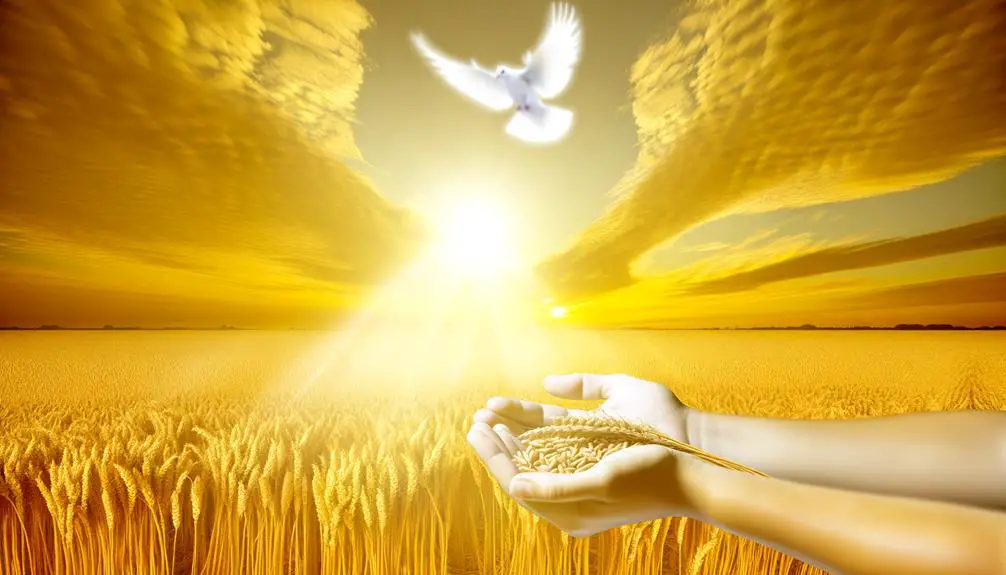
Building upon the rich tapestry of harvest symbolism, we now explore how sheaves serve as potent symbols of divine provision in the biblical narrative. The gathering and bundling of sheaves in ancient agricultural methods were not just about securing the harvest. They were deeply emblematic of God's sustenance and care for His people. Through these practices, you witness a reflection of divine generosity and foresight, ensuring the community's survival through seasons of scarcity.
The process of grain storage further underscores this theme. Ancient granaries, filled with sheaves collected from the fields, were tangible signs of God's provision. These practices weren't merely practical; they were spiritual disciplines, recognizing the source of all sustenance.
Consider how sheaves and their management reflect a broader divine economy:
Aspect of Sheaves |
Significance in Divine Provision |
|---|---|
Gathering |
Act of faith in God's ongoing provision |
Bundling |
Unity and collective stewardship of resources |
Grain Storage |
Wisdom in preparation and trust in future provision |
Agricultural Methods |
Human partnership with divine order in creation |
Harvest Celebrations |
Acknowledgment and gratitude for God's bounty |
Through these elements, you're invited to see beyond mere agricultural practices to a profound exercise in faith. The care with which sheaves were gathered, stored, and celebrated speaks to an ancient understanding of God as the ultimate provider. This recognition wasn't just about thanking God for the present bounty but also an act of trust in His provision for the future. In every sheaf, there was a reminder of the Lord's faithfulness, a lesson as relevant today as it was millennia ago.
Celebratory Psalms and Sheaves

In the biblical tradition, celebratory Psalms intricately weave the imagery of sheaves into expressions of profound gratitude for divine provision, emphasizing the spiritual significance of harvest as a testament to God's enduring faithfulness. You'll find that the Psalms, rich with the language of agriculture, serve not only as a reflection of the society's dependence on farming but also as a metaphor for spiritual bounty and renewal.
The connection between sheaves and celebration in these Psalms offers a powerful insight into the way ancient communities understood their relationship with the divine, particularly in the context of harvest festivals and agricultural practices. Here are some key points to consider:
- Sheaves symbolize God's generosity, reminding us of the material and spiritual sustenance provided to us.
- Harvest festivals, such as Sukkot, become a time for joyous thanksgiving, with sheaves playing a central role in the rituals and celebrations.
- The gathering of sheaves serves as a metaphor for community unity and the collective sharing of God's blessings.
- These Psalms often highlight the cyclical nature of life and agriculture, reinforcing a sense of trust in God's provision year after year.
- Finally, the imagery of sheaves underscores the importance of gratitude and stewardship, encouraging a respectful and sustainable approach to agricultural practices.
Frequently Asked Questions
How Do Contemporary Agricultural Practices Interpret and Utilize the Concept of Sheaves Differently From Biblical Times?
Today, you'll find that contemporary agricultural practices have evolved significantly from biblical times, primarily due to advancements like genetic modification and sophisticated irrigation systems.
These innovations enable crops to be more resilient and productive, altering the traditional concept of sheaves.
While sheaves once symbolized a direct bounty from God, modern practices reflect human ingenuity in crop production, blending faith with science to meet global food demands more efficiently.
Are There Any Specific Rituals or Traditions in Modern Christian Communities That Directly Relate to the Symbolism of Sheaves Found in the Bible?
Yes, modern Christian communities often honor the symbolism of sheaves through harvest festivals. These events aren't just celebrations of agricultural bounty but deeply spiritual gatherings where communal prayers are central.
You'll find these rituals imbued with gratitude for God's provision, reflecting a faith-based understanding of harvest as both a physical and spiritual reaping. They serve as a contemporary bridge to the biblical imagery of sheaves, encapsulating thanksgiving and communal unity.
Can the Concept of Sheaves in the Bible Inform Ethical Agricultural or Environmental Practices Today?
Absolutely, the concept of sheaves in the Bible can guide you towards ethical agricultural and environmental practices. Reflecting on this biblical imagery encourages a connection to the land that aligns with principles of the Green Revolution and ethical consumption.
How Has the Depiction of Sheaves in Biblical Art and Literature Evolved Over the Centuries?
As you delve into the tapestry of time, you'll find that the depiction of sheaves in biblical art and literature has morphed profoundly.
Initially, these artistic symbols and literary motifs served as humble emblems of sustenance and providence. Yet, over centuries, they've blossomed into complex symbols of faith and fertility.
This evolution reflects a scholarly, analytical journey, deepening our understanding of faith-based narratives and their environmental and ethical implications.
In What Ways Has the Interpretation of Sheaves in the Bible Influenced Global Cultural Traditions Outside of Judaism and Christianity?
Your exploration into how sheaves from the Bible have influenced global cultural traditions reveals a fascinating journey of cultural integration. These biblical symbols have woven their way into global festivals, transcending their Judeo-Christian origins.
Analyzing this phenomenon, you find that sheaves symbolize harvest, prosperity, and unity across various cultures, demonstrating a shared human experience. This cross-cultural embrace underscores the power of religious symbols in fostering global connections and understanding.
Conclusion
In exploring the biblical narrative, you've uncovered how sheaves, beyond their agricultural essence, weave into the spiritual tapestry of scripture. Coincidentally, they're not just part of Joseph's dream or harvest celebrations but symbols of Divine provision and hope.
This analysis, rooted in faith, reveals that sheaves in the Bible mirror God's sustenance and mercy. By delving into historical contexts and celebratory Psalms, you've seen how these bundles of grain embody spiritual nourishment, pointing believers towards a bountiful spiritual harvest.


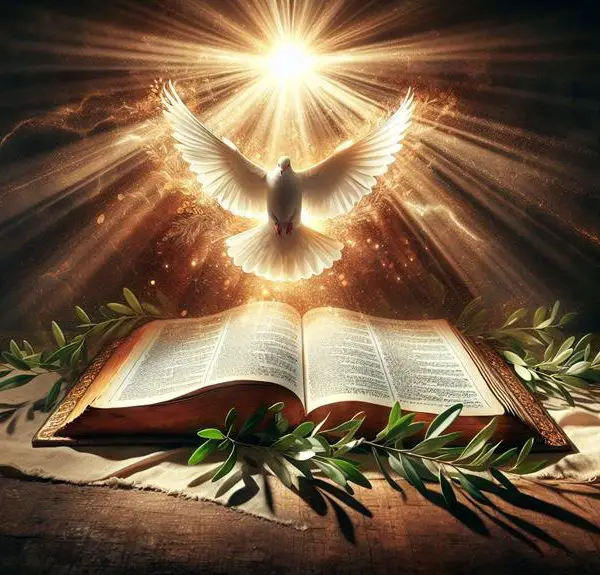
Sign up